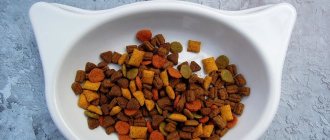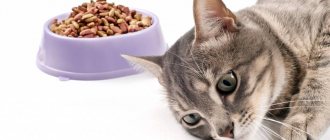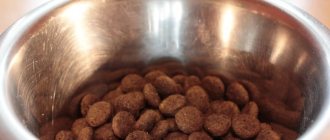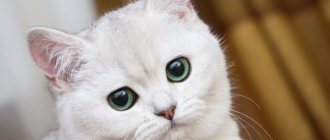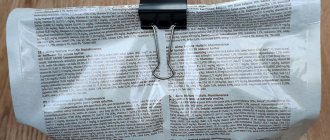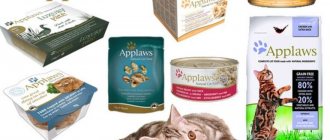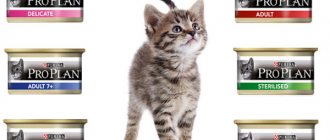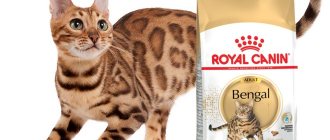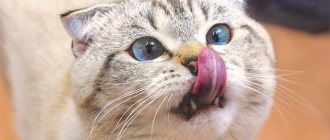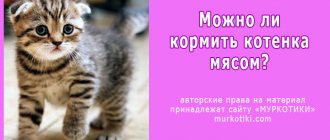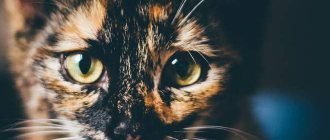The health of pets directly depends on their diet. In addition to poor-quality food, a lack of nutrients or their excess can lead to complications. For this reason, veterinarians recommend measuring the daily portion in grams.
The amount of food per day will vary for cats of different ages and activity levels. When calculating an individual portion, you will need to take into account other important factors affecting metabolism. Otherwise, your pet may suffer from obesity or dystrophy.
How much food to give a cat per day: calculating the daily portion
It is important to note that mixing dry granules and natural products is hazardous to your health. When feeding, you must stick to only one type of food, remembering to follow the recommended dosage.
Dry product
All manufacturers of dry food must place a special table on the packaging indicating how much food a cat needs per day. The calculation takes into account the age and body weight of the animal.
When choosing dry granules, take into account the individual characteristics of your pet. In a pet store you can find lines for certain breeds, pregnant, lactating and sick animals.
For example, let’s take 2 Canadian foods intended for adult cats:
| Brand | Weight, kg) | Daily serving (g) |
| Eukanuba | 2 | 32 |
| 4 | 52 | |
| 6 | 70 | |
| 8 | 93 | |
| 10 | 131 | |
| Now | 2,3-3,2 | 29-40 |
| 3,2-4,2 | 36-58 | |
| 4,5-6 | 52-96 | |
| 6-7,3 | 87-119 |
The difference in recommended volume is due to the size of the granules and their calorie content, and Now also takes into account physical activity. Because of this, focusing on some kind of average is completely pointless.
Pate or spiders
Meat pates and pouches are given in addition to dry granules or separately. The latter option is suitable for cats with dental or gastrointestinal problems.
When calculating the daily dose of wet food, as well as dry food, you should follow the instructions on the packaging. The consumption here is higher, since, unlike granules, dehydration is not used in their production. For 1 g of cat crackers there is at least 2.5 g of pate and 4.5 g of spider meat pieces.
If we carry out the calculation using Eucanuba as an example, then a 6-kilogram cat will need 175 g of pate, or 315 g of meat pieces per day. Please note that these data assume monofeeding of wet food only. When combined with granules, the dosage will be half as much.
Natural food
With natural food everything is much more complicated. Here you will have to take into account not only grams, but also the amount of proteins, fats and carbohydrates. Their percentage should correspond to the following proportion - 52:36:12.
The majority should be products of animal origin (meat, offal, fish, eggs, dairy products), and the smaller portion should be products of plant origin (cereals, vegetables, fruits).
The daily portion should be about 5% of the cat's body weight. If your pet weighs 4 kg, then it is recommended that he eat 200 g of natural food.
Despite its simplicity and convenience, this formula does not take into account a number of important factors. For this reason, it is much more reliable to calculate not grams, but the total calorie content - 90 calories per 1 kg of animal weight.
What nutrients do cats need and why?
Protein
Cats have almost 3 times more need for protein than dogs; they really can’t live without it. In addition to the fact that mustachioed pets have an exceptional need for a constant supply of essential amino acids to the body, there is also a difference in protein metabolism. If there is a lack of protein in food, the liver will begin to consume it from the cat’s body, depleting it. In dogs, the speed and level of its decomposition reflexively decreases, due to which its preservation and need increase.
Such a high need is explained by the body’s constant need for essential amino acids - leucine, threonine, arginine, lysine, phenylalanine, etc. These substances are needed to maintain the normal condition of the coat, as well as for a sufficient amount of feline - a unique substance excreted in cats in the urine. There is especially a lot of it in cats - it is this that gives such a pungent smell to the urine of adult sexually mature individuals.
Another very important essential acid for Murok and Murzikov is taurine. It is synthesized in the body of dogs, but not in cats. This amino acid is absent in protein, but is found in muscle fibers of animal origin, i.e. meat is a pure protein product. Lack of dietary intake leads to disruption of the reproductive system, cardiovascular system and destruction of the retina. There are even special taurine deficiency syndromes associated specifically with disruption of the above-mentioned organs and systems.
Protein must be supplied to cats' bodies constantly! Source of protein for cats: meat, fish, dairy products. Source of taurine: meat and fish (mostly in turkey and raw tuna).
Fats
Not only the energy value of the food depends on this nutrient, but also its palatability for animals (of course, vegetable oil for a cat will be less attractive in smell and taste). In addition to energy, fats in the body perform two more very important functions - they dissolve fat-soluble vitamins into an easily digestible state and are a source of essential fatty acids. A cat's daily diet should contain at least 15% fat, and if it is a kitten, then all 20%.
Source: animal and vegetable fats.
Carbohydrates
They consist of difficult-to-digest (fiber) and easily-digestible (starch and sugar). Fiber is needed for physiologically normal fecal formation. With enough of it - as much as needed - the cat will never have constipation or diarrhea due to nutrition. An excess of easily digestible carbohydrates leads to obesity and can trigger the development of diabetes.
Cats should receive 0.32 g of fiber and no more than 2.7 g of easily digestible carbohydrates per kilogram of weight per day.
Source of carbohydrates for cats: cereals (buckwheat, rice), bran, honey. The fiber comes from the same place plus vegetables.
Minerals and vitamins
Like any living organism, cats also need vitamins and minerals. The need for these substances can be met with the help of special vitamin complexes and feed additives. There are several nuances: cats do not need vitamin C, because... They produce it in the liver, but they need direct vitamin A, not beta-carotene, because the transformation of one substance into another does not occur in their body. This means that you should not feed Murka citrus fruits during a cold, and carrots in the diet should be replaced with liver.
Author:
Grinchuk Ekaterina Andreevna veterinarian
How many calories do you need per day
The total calorie content is calculated using the following formula: K*(30*m + 70), where K is the multiplier coefficient, and m is the body weight of the animal. And if everything is clear with indicator 2, then the required coefficient value can be found in the table below.
| Physiological features | K |
| Obesity diagnosed by a veterinarian | 0,8 |
| Tendency to overeat, fraught with rapid obesity | 1 |
| Elderly age | 1,1 |
| Spayed and neutered animals | 1,2 |
| Kitten or adult pets with a small body weight | 1,2-1,4 |
| Inactive adult cat | 1,4 |
| Active adult cat | 1,6 |
| Gestation period for kittens | 1,6-2 |
| Breastfeeding period | 2-4 |
If your pet weighs 5.5 kg, constantly begs and eats everything that is not nailed down, and his furry body can hardly fit into his own house, then he will need 235 kcal per day. Please note that this is not a single portion, but a daily one. It will need to be divided by the number of feedings (usually 2).
Another example is the chicken-flavored Eukanuba. The calorie content of the granules is 4000 kcal per 1 kg, and the weight of the pack is 2 kg. That is, our hypothetical cat will have enough of this pack for 34 days (4000 kcal * 2 kg/235 kcal).
The required number of grams can be found by dividing 2 kg by 34 meals received previously. When rounded, the result is 59 g, and this figure actually fits into the standards specified by the manufacturer.
How many feedings should I divide the daily norm into?
The number of feedings per day directly depends on age. Most often eaten by kittens, which have a fast metabolism.
Kittens
For the first 2-2.5 months, kittens feed on breast milk. Complementary feeding begins only at 3-4 weeks, when the furry babies have baby teeth. But, if your pets are left without a mother too early, then you will have to think about the feeding regime soon after their birth.
The main recommendations can be found using the table:
| Age | Feeding frequency |
| Less than 3 weeks | Every 2-3 hours, that is, about 7-8 times a day without night breaks |
| 3 weeks – 1.5 months | 6-7 times a day with a night break within 5 hours |
| 1.5-2 months | 6 times a day |
| 2-3 months | 5 times a day |
| 3-6 months | 4 times a day |
| 6-8 months | 2-3 times a day |
After reaching 6-8 months, the diet and feeding regime gradually approaches that of an adult. At this point, pets reach puberty.
Adults and elderly animals
Adult cats are fed twice a day, while older cats (over 7 years old) are fed only once a day. Your veterinarian can make changes to this regimen.
Most often, the number of meals is increased in case of gastrointestinal diseases, when the stomach and intestines are unable to digest too large volumes. By reducing the single portion, it is possible to reduce the load on these organs.
What to feed a kitten
The first weeks of life are very important for a small kitten, since during this period taste preferences are formed and the functioning of the digestive organs is normalized. Therefore, it is very important with the question of how to properly feed a young cat or cat, it is better to immediately contact a veterinarian. Vitaminized foods are especially useful according to your pet’s age category.
If you feed a kitten with such store-bought products, it is important to understand that over time it will hardly be possible to switch it to food from the common table. In order for the animal to quickly gain weight without “earning” chronic kidney disease, it is better to independently prepare natural, healthy food for the younger generation. It is important to periodically change your diet, thus strengthening the immune system and systemic digestion.
- How soon after training can you eat and drink?
- Waffle rolls - a recipe for an electric waffle iron. Recipes for dough and filling for waffle rolls with photos
- How to cook fish soup
When should you increase/decrease the rate?
Adjustment of the norm is necessary for obvious signs of obesity or underweight. A number of physiological characteristics (most of them were mentioned when calculating the coefficient for determining caloric content) and external factors should also be taken into account.
Physical activity
Active pets with constant access to the outdoors expend much more energy than their furry counterparts lounging on the couch. For this reason, they need to eat more than usual in order not to lose their muscle mass and stay healthy. Often 15% of the total portion is added to the daily intake of active pets.
Age
Growing kittens can boast of fast metabolism. The food they eat is spent on building the skeleton, muscles and other equally important tissues. Because of this, they rarely gain weight and constantly want to eat.
It's different for older animals. With age, all internal processes slow down. The quality of teeth and gums deteriorates. Food becomes more difficult to chew, and the usual volumes increasingly remain untouched. The activity of such cats is very low, so less and less calories are required to maintain the body.
Restructuring the body after castration or sterilization
After surgery, the animal's hormonal background undergoes a number of changes. Despite the slowdown in metabolism and loss of usual activity, appetite remains the same or even increases.
Due to lack of saturation, a neutered cat quickly gains excess weight. Without owner intervention, it may suffer from obesity and other pathologies associated with this disorder.
In addition to reducing calories, it is recommended to switch to a special ready-made diet for sterilized animals. It has a moderate amount of fat and carbohydrates, and also helps speed up metabolism and maintain muscle mass.
Pregnancy and lactation
From the table above you can see that pregnant and lactating cats require the most calories. At 2 weeks of pregnancy, the volume of food should be increased by 10-15%, and at 3 – by 50%.
After the kittens are born, the caloric content of the diet is again increased so that the mother has enough nutrients for both herself and the cubs. It is better to consult a veterinarian about the exact numbers, since the number of babies and the volume of milk play a big role.
External factors
The need for food is directly related to weather conditions. In winter, a lot of energy is used to heat the body, so to replenish it you have to eat more than usual. In summer, the situation is reversed, so don’t be surprised if your pet once again ignores his favorite treat, but drinks cool water with pleasure.
Complete refusal of food is one of the symptoms of infections, parasitic infestations and systemic pathologies. Due to intoxication, inflammatory processes and dysfunction of internal organs, the need for food is significantly reduced. You can suspect something is wrong by the accompanying symptoms: vomiting, diarrhea or constipation, itching, fever, cough, strange discharge from the nose or eyes.
How can you tell if an animal is undernourished or overfed?
All mustachioed pets can be divided into 2 groups: picky and glutton. Only a few eat their quota, so owners have to monitor the health of their pets by regularly measuring body weight.
Weight control
You can control your weight using scales or visually. In the first case, the pet must be weighed every week so as not to miss deviations. With an increase in body weight, the calculated dose is reduced, and with a decrease, it is increased.
For visual assessment, palpation of the ribs and spine is used. They should be easily palpable, but not protruding. If they are hidden by a layer of fat, the cat needs to be put on a diet. If the situation is the opposite, then, most likely, other alarming signs will be observed: lethargy, hair loss and abdominal collapse.
If your pet is constantly begging
When fighting begging, you need to show persistence and steadfastness. To begin with, you should refuse to feed on your pet’s command. Don't buy into his pitiful cries and unhappy eyes. If the weight is within the normal range or above, then a daily portion is more than enough for him.
Particular attention should be paid to the regime. Feed your mustachioed beggar at certain hours and do not deviate from the schedule. The breaks between meals should be approximately the same.
It is also recommended to temporarily give up treats and be sure to replace cheap dry granules with flavors with a less attractive, but more healthy analogue of at least a premium class. Over time, the animal will understand that its tricks do not work and will calm down.
Why is it important?
In nature, cats eat irregularly and sometimes not enough, but they have to move a lot, so they always remain slim. In our houses and apartments, everything happens exactly the opposite: there is no need to spend hours tracking down prey and escaping from enemies, the sofa is warm and soft, and there is always plenty of food in the bowl. This is why many domestic cats are overweight.
Sometimes owners are only touched by this fact, although it is high time to sound the alarm. After all, obesity threatens serious diseases and reduces the pet’s quality of life and its duration.
By following the norm of dry cat food, you can prevent the problem of excess weight or solve an existing one. To do this, you don’t have to weigh yourself and count calories every day, because dry food is very easy to dose. It is enough to correctly measure the norm once on a kitchen scale or with a measuring cup, and then adjust it from time to time.
Useful tips for cat owners
In conclusion, it is worth noting a few more nuances. They relate to the drinking regime and measuring the required number of grams.
Drinking regime
Water plays a huge role in the life of every organism. To maintain metabolic processes, you need to regularly drink your daily fluid intake. For adult representatives of the cat family it is 31.5 ml per 1 kg, and for kittens – 77 ml per 1 kg.
Please note that the body receives part of the fluid from food. For this reason, the recommended indicator may deviate more or less for different types of nutrition.
In addition to volume, you need to take care of quality. Tap water contains a lot of salts and metals, so drinking it increases the likelihood of developing urolithiasis. Instead, you should give bottled water or use a special filter. It is recommended to change the water 1-2 times a day, since otherwise pathogenic microorganisms begin to actively multiply in it.
